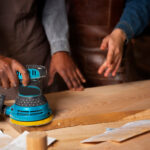Learn about Nails, Glue, Glue Assist, or Glue with Moisture Barriers
Engineered hardwood flooring provides a versatile and durable option for enhancing the beauty of residential and commercial spaces. One crucial aspect of installing engineered hardwood floors is selecting the appropriate installation method. In addition to nailing, gluing, and using glue with moisture barriers, there’s also the option of utilizing a glue assist method. Let’s explore these four installation methods in detail to help you make an informed decision for your flooring project.
Nailing:
Nailing, also known as staple-down installation, involves securing engineered hardwood planks to the subfloor using nails or staples. This method is commonly used for installations over plywood or wood subfloors. You want to make sure to have the nailing correct so you do not hurt the engineered hardwood veneer.
Advantages:
- Provides a secure and stable installation.
- Facilitates easier removal and replacement of individual planks if necessary.
- Minimizes adhesive-related issues such as bonding failures or off-gassing.
Considerations:
- Requires access to a pneumatic nail gun or stapler for efficient installation.
- Subfloor preparation is critical to ensure a flat and level surface.
- May not be suitable for concrete subfloors without additional subflooring materials.
Gluing:
Gluing, or full-spread adhesive installation, entails applying adhesive directly to the subfloor and then laying engineered hardwood planks onto the adhesive. This method creates a strong bond between the flooring and the subfloor, resulting in a seamless and stable installation.
Advantages:
- Provides excellent stability and sound insulation.
- Eliminates the need for nails or fasteners, resulting in a clean appearance.
- Suitable for installation over various subfloor materials, including concrete, plywood, and existing flooring surfaces.
Considerations:
- Requires careful application of adhesive for proper coverage and bonding.
- Longer installation time compared to nailing or floating methods.
- Some adhesives may emit volatile organic compounds (VOCs) during installation, necessitating proper ventilation.
Glue Assist:
Glue assist combines the benefits of both nailing and gluing methods. In this approach, adhesive is applied to the subfloor, and engineered hardwood floor planks are nailed or stapled in place while the adhesive is still wet. This method enhances the bond between the flooring and the subfloor, providing additional stability and durability.
Advantages:
- Offers enhanced stability and adhesion compared to nailing or gluing alone.
- Provides a secure installation while allowing for easier removal and replacement of planks.
- Suitable for areas where extra bonding strength is desired, such as high-traffic zones or commercial spaces.
Considerations:
- Requires coordination to ensure that planks are installed while the adhesive is still wet.
- Subfloor preparation and adhesive application must be carried out with precision to achieve optimal results.
- May involve higher labor costs due to the additional steps involved in the installation process.
Glue with Moisture Barriers:
Gluing with moisture barriers combines adhesive installation with the added protection of moisture barriers. Moisture barriers help prevent moisture from penetrating the subfloor and damaging the engineered hardwood flooring, making this method ideal for moisture-prone areas.
Advantages:
- Provides enhanced protection against moisture-related issues such as warping or mold growth.
- Helps maintain the structural integrity and longevity of the flooring.
- Suitable for installation in basements, bathrooms, or other high-moisture environments.
Considerations:
- Requires proper surface preparation and installation of moisture barriers to ensure effective protection.
- May involve additional materials and labor costs compared to standard gluing or nailing methods.
- Careful selection of moisture-resistant adhesives and barriers is essential to ensure compatibility and effectiveness.
Conclusion:
When selecting the installation method for engineered hardwood floors, consider factors such as subfloor material, environmental conditions, budget, and personal preferences. Whether you choose nailing, gluing, glue assist, or gluing with moisture barriers, each method offers distinct advantages and considerations. By understanding the characteristics of each installation method and assessing your specific needs, you can make an informed decision that ensures a successful and long-lasting flooring installation. After installation you might want to look into the maintenence and how it is done.
Author Profile
- I have worked in hardwood flooring for the last 8 years. Use to run a company of residential crews as well as a company with gym flooring. If you need floor installation or refinishing help, I should have an answer or at least get you in the right direction.
Latest entries
 FlooringNovember 25, 2025What Engineered Hardwood Flooring Will Last Longest?
FlooringNovember 25, 2025What Engineered Hardwood Flooring Will Last Longest? FlooringNovember 22, 2025Best Wood Floor Cleaner Liquid for Hardwood Flooring
FlooringNovember 22, 2025Best Wood Floor Cleaner Liquid for Hardwood Flooring FlooringNovember 21, 2025How To Remove Adhesive From Hardwood Floors?
FlooringNovember 21, 2025How To Remove Adhesive From Hardwood Floors? FlooringNovember 17, 2025Best Sanding Machine For Hardwood Flooring
FlooringNovember 17, 2025Best Sanding Machine For Hardwood Flooring
